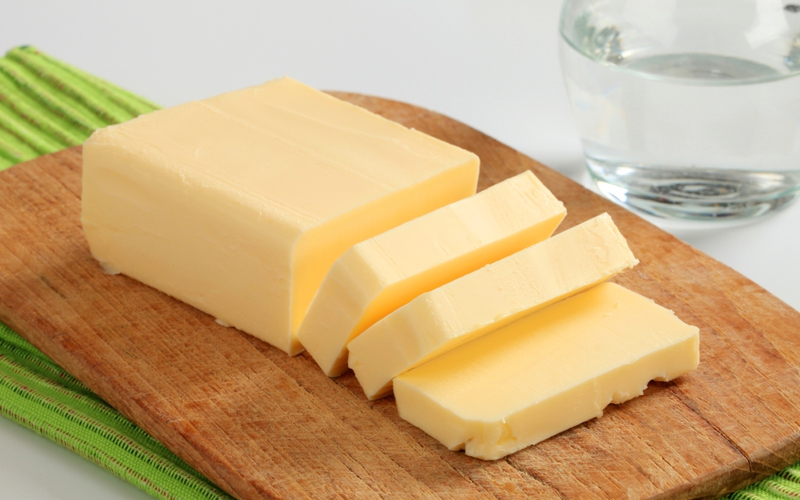Lactose is a type of sugar found in milk and other milk products. In the body, lactose is broken down with the aid of an enzyme called lactase. However, some people are lactose-intolerant because they do not have enough of the enzyme, which causes them to experience side effects like gas, bloating and diarrhea after taking milk products. But, you may wonder, does butter have lactose?
If you have been avoiding milk and other products containing milk due to their side effects, do you also need to avoid using butter? You may also want to know the amount of lactose in butter, and whether or not it is large enough to cause symptoms of lactose intolerance.

Does Butter Have Lactose?
What Is Lactose?
Lactose is a type of complex sugar that is found in cow milk. It is hard to digest in your body, so you need lactase, an enzyme that breaks down lactose into simple sugars called galactose and glucose. These simple sugars are more easily absorbed and used by the body. If you do not produce the right amount of lactase, lactose will remain in the gut and cause inflammation, which can irritate the intestines. This condition, known as lactose intolerance, usually begins during adolescence and becomes more common during adulthood.
Does Butter Have Lactose?
Cow's milk contains a lot of lactose (13 grams per 8-ounces of milk), therefore you must definitely avoid taking milk if you are lactose-intolerant. But does butter contain lactose? Yes, it does, but butter, derived from milk fats, only contains very little lactose about 0.01 gram/tablespoon butter. So you may have some butter without being afraid of the side effects, even if you are lactose intolerant.
However, for a few individuals, even a very small amount of lactose might cause bloating, nausea, abdominal cramps and diarrhea. In this case, the gastrointestinal effects of lactose in butter are more likely to be due to other ailments, such as food allergies, foodborne illness or chronic bowel disorders like Crohn's disease. Consult your doctor about it for proper diagnosis and treatment. You may also want to verify "Does butter contain lactose?" with your doctor again.
If I'm Allergic to Lactose in Butter, What Should I Do?
Turn to Lactose-Free Products
When buying lactose-free products, you should ask yourself, "Does butter have lactose?" and "What does lactose-free means?" Lactose-free products should not contain lactose, but they might contain other components of dairy products, which might be safe for lactose intolerant individuals but not for people who have milk/dairy allergy.
Care for Dairy-Free Products
So, if you are worried about lactose in butter, you might want to try dairy-free products, which do not contain lactose, are safe for those who have lactose intolerance or milk allergies, and are also preferred by vegans.
Remember, however, that dairy-free is not the same as "non-dairy", which are products allowed by the FDA to contain whey and other milk byproducts, like casein, the substances causing milk allergy and found in milk, cheese, cream and butter.
Manage Your Lactose Intolerance Symptoms
There is no cure for lactose intolerance, but you can reduce your symptoms by doing a few lifestyle changes. Avoid anything that contains lactose, like milk, yogurt, or ice cream. Butter has very little lactose, so you can have it every now and then. If you occasionally crave dairy foods like ice-cream, you can try taking an over-the-counter enzyme (lactase) before eating the food. Of course, it is best to ask your doctor about this. If butter causes your belly to rumble, take the lactase enzyme before eating food with butter.
Mind What You Eat
Find alternatives for butter if you have trouble even with tiny amounts of lactose. Try margarine products that are lactose-free. These are often made from plant-based oils, which do not contain lactose. Read labels carefully and watch for "lactose-free" or "dairy-free" labels. Read through their ingredient list and see if milk, milk solids, buttermilk or other milk derivatives are included.
Other Suggestions on Alleviating Lactose Intolerance
Other general guidelines to manage lactose intolerance include:
Add small amounts of lactose in your diet gradually to find out your tolerance levels. Some people are able to tolerate up to half a cup of milk without getting symptoms.
Drink milk in small servings only.
Eat hard cheeses like cheddar, which has low lactose content.
Drink milk together with other foods.
Try probiotic-containing yogurt. Active cultures of friendly bacteria help you to better digest yogurt.
Instead of regular dairy products, use lactose-reduced products and lactose-free milk, which may be found in most supermarkets.
Take 1 to 3 tablets of lactase enzyme such as Lactrace®, Lactaid®, Dairy Ease®, or Sure-Lac® before consuming foods that contain lactose.
Try nutritional supplements (such as Boost® or Ensure®,), which are lactose-free.

View All Comments /Add Comment